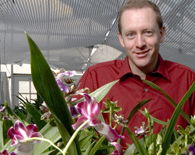Alternative Energy for Stimulating Economic Competitiveness
Efforts help keep Michigan's greenhouse industry competitive
- Erik Runkle, Ph.D.
- Associate Professor, Department of Horticulture
- College of Agriculture and Natural Resources
- Stephen Harsh, Ph.D.
- Professor, Department of Agricultural Economics
- College of Agriculture and Natural Resources
Since 2004, energy costs have escalated by 30 to 50 percent, reducing the profitability of Michigan's greenhouse industry by more than $20 million in 2005. Two MSU researchers, Stephen Harsh, professor of agricultural economics, and Erik Runkle, associate professor of horticulture, are spearheading a project to identify alternative energy sources and innovative strategies for reducing energy costs and helping the state's floriculture industry regain its competitive edge.

Alternative Energy for Stimulating Economic Competitiveness
Harsh and Runkle study how greenhouse operators deal with similar situations in other areas of the world. The quest took them to the Netherlands, the top-ranking country in greenhouse crop production, to survey how growers there responded to a government-imposed mandate to reduce climate-warming gases by 40 percent.
Because the climate of the Netherlands is similar to Michigan's, they were interested in studying the practices that operators there were using to help reduce greenhouse energy costs. The most interesting method that Harsh came across during his weeklong November 2006 trip was cogeneration, a technique used to produce heat and carbon dioxide for the greenhouses and electricity for the town at the same time.
"The trip to the Netherlands really opened our eyes to how many opportunities exist for generating alternative energy," Harsh said. "The government of the Netherlands has implemented important regulatory policies to encourage greenhouses to commit to conserving natural resources."
Although the cogeneration system is not used in the United States, Harsh came across other promising methods worth further study. For example, during the warm months, greenhouses in the Netherlands capture solar energy by using heat exchangers in the greenhouses and storing it in an aquifer. During the cool months, the stored energy is used to heat the greenhouses. Other alternative energy technologies used by the people of the Netherlands include wind energy, biomass (wood pellets), other alternative fuels and various types of glass or plastic.
"Energy is usually one of the greenhouse industry's top two highest priorities, because, on average, it accounts for between 8 and 12 percent of a producer's total expenses," Runkle said. "Because there is not one single best way to reduce energy costs that's right for everyone, growers have several options to choose from."
Runkle is working on methods to reduce greenhouse energy costs by developing a better understanding of how crops respond to temperature. The temperature in a greenhouse dictates how long it will take for a crop to reach maturity. Plants grown in cooler temperatures take longer to develop; plants grow much faster in warmer temperatures. Runkle and Ph.D. graduate student Matthew Blanchard are trying to identify the optimum temperature that would permit energy costs to be lowered without jeopardizing plant growth rate.
"We predict that growers may be able to save up to 10 to 30 percent on energy costs by managing greenhouse temperature," Runkle said.
Because every plant responds differently to varying temperatures, the USDA in Toledo, Ohio, is partnering with Runkle to build a user-friendly computer program to generate mathematical models that can forecast how well various crops can be expected to grow at specific temperatures. Runkle said the computer program, which is still under development, will allow users to select the type of crop they wish to grow and then recommend the most profitable temperature at which to grow the plants.
"The program will help growers determine their expected energy costs," Runkle said. "Before they grow a crop, growers will have a good forecast of what their energy consumption levels will be."
To reach growers in many locations, Runkle and Blanchard created a Web site called Greenhouse Cost Reduction Strategies. The site includes a compilation of studies on how to reduce energy costs conducted by researchers from MSU and other universities. Though the site is targeted at Michigan growers, the information is applicable to many other regions of the northern United States with similar climate patterns.
"We hope to help Michigan's greenhouse industry remain a competitive and dominant player," Harsh said. "Our goal is to learn how the industry can become more efficient and competitive, and identify the role it can play in reducing carbon emissions."
Runkle and Harsh received funding from Project GREEEN (Generating Research and Extension to meet Economic and Environmental Needs), Michigan's plant agriculture initiative at MSU, to conduct their research. Additional funding support was provided by the Michigan Floriculture Council.
To learn more about Michigan's plant agriculture initiative at MSU, visit the Project GREEEN Web site.
- Written by Sara Long, ANR Communications